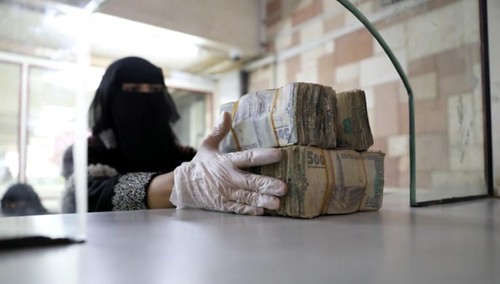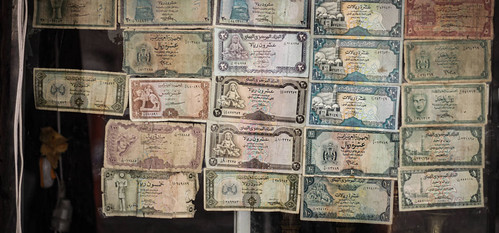
PREV ARTICLE
NEXT ARTICLE
FULL ISSUE
PREV FULL ISSUE
YEMEN'S RIVAL BANKNOTESJP Koning writes: "Here are some interesting stories about Yemen riyal banknotes. Apparently the Yemeni central bank has split into two. One of the central bank branches has issued new notes, but the other won't accept them. As a result, an exchange rate has emerged between old and new Yemen riyal notes." Thanks. I'd seen some articles about the situation, but don't think we've mentioned it yet in The E-Sylum. -Editor 
An employee takes bundles of Yemeni Riyal at the Central Bank of Yemen in Sanaa Yemen’s warring sides opened a new front in their five-year conflict on Saturday - a battle over old and new banknotes that threatens to create two economies in the same state. As of midnight, the Houthi movement which controls the capital Sanaa outlawed the use and possession of crisp new Yemeni riyal bills issued by its rivals in the internationally recognized government based in the southern port town of Aden. The Iran-allied Houthis, who say people should only use the old bills, have defended the ban as a move against inflation and what they call rampant money-printing by the government. The government has branded the ban an act of economic vandalism. And the population, as ever, have been left stuck in the crossfire. To read the complete article, see:

Old Yemeni rial banknotes on display in a shop window From the internationally recognized Yemeni government’s interim capital of Aden, the central bank’s relocated headquarters has kept the institution’s international recognition, allowing it to, among other things, print currency and access international financial markets. Meanwhile, the central bank’s historic home in the capital, Sana’a, controlled by the Houthi group, has maintained its purview over the country’s largest consumer markets and financial centers. The battle between the central banks entered a dangerous new phase on December 18, 2019, when the Sana’a branch banned newly-printed currency bills issued by its Aden rival and gave residents of Houthi-held areas a one-month window to trade in the "illegal" bills for either old ones – issued pre-September 2016 – or a new electronic currency the Houthi authorities are trying to implement. Turmoil has ensued. This paper traces the beginnings of Yemen’s currency war and how monetary policy became fractured across frontlines. It examines the impacts of divided monetary supply management, as well as Houthi attempts to undermine Aden central bank policies and keep the country’s financial markets tethered to Sana’a. The Houthi decree in December 2019 marked a clear escalation in the currency war; this paper details the new banknote ban, how its enforcement has varied by region, as well as the e-Rial and its likely terminal flaws. Market reaction to the banknote ban has seen flourishing black market currency trading, currency smuggling across frontlines, and the emergence of increasingly divergent exchange rates around the country as new rial banknotes have flooded back to government areas. In institutionalizing two monetary systems the Houthi move has had the political effect of furthering the emergence of distinct statelets within Yemen’s borders. To read the complete article, see:
Wayne Homren, Editor The Numismatic Bibliomania Society is a non-profit organization promoting numismatic literature. See our web site at coinbooks.org. To submit items for publication in The E-Sylum, write to the Editor at this address: whomren@gmail.com To subscribe go to: https://my.binhost.com/lists/listinfo/esylum All Rights Reserved. NBS Home Page Contact the NBS webmaster 
|